Table of Contents
Introduction:
In the digital world of today, a business needs a strong IT system to run well. But it’s not enough to just have technology. Strategic IT infrastructure project management is what you need to grow and be ready for the difficulties of the future. For your business to be ready for the future, this (blog) post goes into great detail about why well-planned IT infrastructure projects are so important. We will talk about how good IT infrastructure project management can help you build a strong base, make the most of cloud strategies, and pick the best IT infrastructure management software. Prepare to learn how to create a strong and flexible IT system that will last the life of your business!
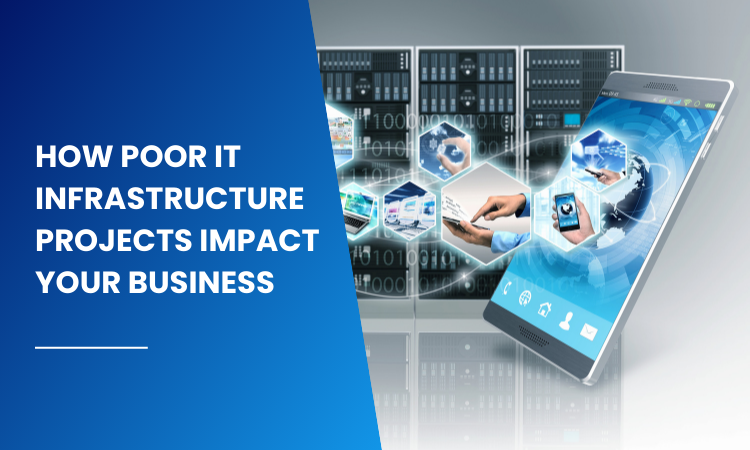
1. The Domino Effect: How Poor IT Infrastructure Projects Impact Your Business:
Let’s say you just finished installing new data cables in your office. It perfectly meets all of your needs right now; everyone has the connection they need. But let’s jump ahead a year. Your business grows quickly, which means it needs more bandwidth and maybe a new area that needs to connect to the network. All of a sudden, your once-perfect method for wiring feels limiting. Now is the time to hire a data-cabling project manager who can see how the business will grow in the future.
The unseen network of cables that sends data is called data cabling. It is the physical backbone of your IT system. A good (data cabling project manager) does more than just meet the needs of the moment. As a key partner, they make sure that your infrastructure for cables is scalable and flexible. This is how they prepare for the future:
Planning for Scalability: They carefully look at how much data you are using now and guess how much it will grow in the future. This could mean adding more conduit space during installation so that it’s easy to add new wires as your network grows.
Not Dependent on Technology Design: Copper connections are still used a lot, but managers who are looking to the future think about how technology will change in the future. They might suggest putting in high-bandwidth fiber optic lines along with regular copper ones. This “technology-agnostic” method gives us the freedom to use new high-speed technologies as they come out.
Modular Cabling Plant Design: Another important place to prepare for the future is the cabling plant, which is where all the network links are kept. Data-wiring project managers plan modular plants that can be easily expanded. This makes sure that adding new network parts or moving old ones around is easy.
2. Building for Tomorrow: IT Infrastructure Trends to Consider in Project Management:
For IT infrastructure project managers to do their jobs well, they need to stay ahead of the curve all the time. When you plan your next job, here are some important trends to hold in mind:
It’s no longer a “maybe” to use the cloud; it’s a “must-have.” Plan for cloud tactics, project managers need to do. Making sure that on-premise and cloud settings work together smoothly could mean moving existing infrastructure to the cloud, creating hybrid cloud solutions, or moving existing infrastructure to the cloud.
AI and ML are changing the way IT infrastructure is managed. With tools that use these technologies, project managers can automate boring jobs, see what problems might come up, and make the best use of their resources.
Cybersecurity is still a big problem, even though security threats are changing. As soon as the project starts, project managers need to make strong security steps a top priority. Using zero-trust architecture concepts, security best practices, and solutions like data encryption are all part of this.
When everything is software-defined (SDx), it’s easier to manage IT systems and gives you more control over them. As a way to make projects more flexible and scalable, project managers should think about using SD technologies like Software-Defined Networking (SDN) and Software-Defined Storage (SDS).
Pay attention to user experience (UX). IT infrastructure works for people who use it. How the design of infrastructure affects the user experience is something that project managers should think about. Prioritizing solutions that make sure the network works quickly and reliably, applications can be accessed easily, and users can move around easily might be one way to do this.
3. Aligning with the Cloud Gurus: How Gartner Insights Shape IT Infrastructure Projects:
For IT infrastructure professionals, finding the best way to move forward can be hard because things are always changing. Do not worry, though! Leading IT research and consulting company Gartner can help you make important choices about managing your IT infrastructure.
How using Gartner’s knowledge can help your projects succeed:
The “Magic Quadrant for Cloud Infrastructure and Services Providers” published by Gartner every year is a great tool for comparing cloud service providers. Researchers and project managers can use this report to find the best cloud platform for their needs and make sure that their existing infrastructure works well with the chosen cloud option.
According to Gartner, the Hype Cycle studies are helpful for understanding how mature different IT trends are. Utilizing this data, project managers can decide which technologies, such as containerization or edge computing, to adopt first, while avoiding solutions that aren’t fully developed yet that could cause problems with their projects.
Gartner puts out a lot of study on IT infrastructure project management best practices. Utilizing these tools, project managers can learn more about things such as server consolidation, emergency recovery planning, and ways to lower the costs of IT infrastructure. This information gives them the power to make smart choices throughout the entire project lifecycle.
Gartner has tools for project managers that let them compare the performance metrics of their IT systems to the broader industry averages. Using this information to find ways to make things better will give your project a competitive edge.
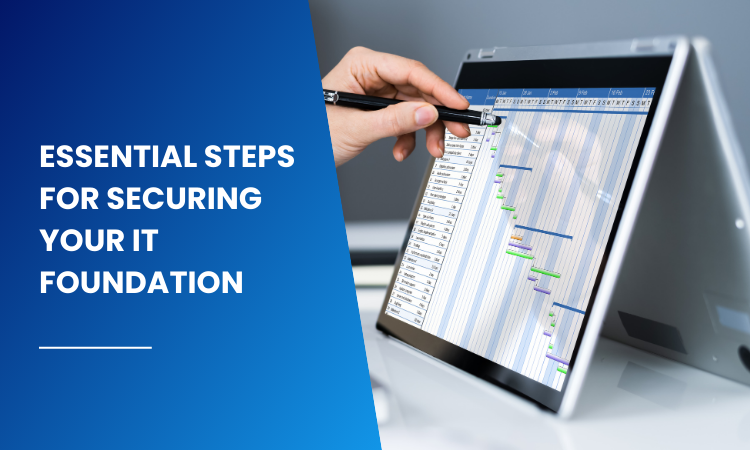
4. The IT Infrastructure Project Management Checklist: Essential Steps for Securing Your IT Foundation:
Precise planning and performance are needed for an IT infrastructure project to be a success. Make sure your business has a strong IT base by following this helpful checklist:
Summarize the situation and set objectives. Make it clear what the project’s goals are—what do you want to realize? Changing to the cloud, updating old hardware, or putting in place a new security system? Clearly stating the project’s goals and objectives helps it stay on track and perform as planned.
Assemble Your Team. Put together a group of people who have the right skills. Information technology (IT) experts, network engineers, project managers, and even outside advisers could be included. Define roles and tasks clearly to make sure the project goes smoothly.
Conduct a Needs Assessment. Look at your existing IT infrastructure very carefully. What problems are you currently having? Are you expecting your business to grow in the future? Discovering the best answers requires knowing your “as-is” situation.
Make a project plan and budget. Make a thorough project plan with timelines, deliverables, milestones, and budgeting for resources. Setting a reasonable budget for the whole project is also very important. This should include hardware, software, and any possible labor costs.
Pick the Correct IT Infrastructure Management Software. Buying software for managing your IT infrastructure can make your project and running it easier. Check out tools that let you do things like reports, keeping track of assets, and managing configurations.
If your project involves moving or integrating the cloud, you might want to make sure your method is in line with Gartner’s research on cloud providers and strategies. Making this change makes sure everything goes smoothly and gets the most out of using the cloud.
Put your project plan into action and keep an eye on it. Follow the set deadlines and funds and do everything exactly as planned from the project plan. You can keep track of progress and find possible problems with the IT infrastructure management software you’ve chosen.
Review after implementation. A full review should be done once the job is finished. It is important to compare the results to the goals that were set and find ways to make it better. What you’re learning here could be very useful for projects in the future.
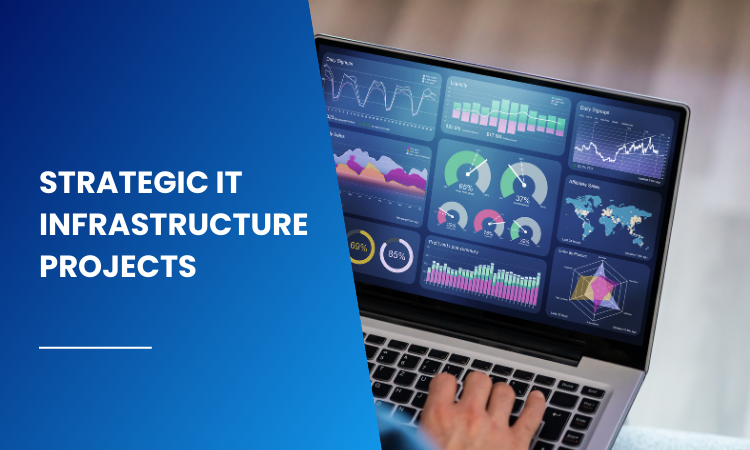
5. Beyond Basic Upgrades: Strategic IT Infrastructure Projects for Long-Term Growth:
A lot of companies see IT infrastructure projects as a quick way to fix problems, like upgrading old gear or adding more storage space. Even though these upgrades are necessary, a real IT infrastructure plan goes beyond just fixing things. To help your business grow in the long run, use IT (infrastructure project management) in the following ways:
Pay Attention to Business Alignment: You shouldn’t just improve because you can. Align your IT infrastructure projects with the bigger goals of your business. Is your business going into new areas? If you want to use a new CRM system, you might need to make changes to your technology to allow for more data storage and user access.
Accept Automation and Efficiency: IT infrastructure projects can be a great chance to automate boring jobs that need to be done by hand. You might want to use infrastructure management software that can automatically set up servers, handle their configurations, and apply patches. This gives IT staff more time to work on growth-boosting key projects.
Set Goals for Scalability and Flexibility: Your IT system needs to be able to change with the needs of your business. If your business grows, look for options that are easy to expand, so you can add more resources or features. In this case, cloud-based technology can be very helpful because it allows for on-demand scalability and flexibility.
Invest in Security: There are always threats to your online safety. Do not put security last on your list of priorities. Strong security methods should be built into all of your IT infrastructure projects from the start. To do this, you might need to divide the network into sections, secure the data, and set up a zero-trust security model.
Plan for the Future: IT infrastructure project management that works well looks at the big picture. You might want to think about new technologies like AI and machine learning. Your system should be able to connect these technologies so that you can find new ways to grow and innovate.
6. From Reactive to Proactive: IT Infrastructure Management Software Saves the Day:
Let’s say you’re in the middle of a very important talk when all of a sudden, the network goes down. Colleagues who are angry scramble to get back online, which causes panic. This reactive method of managing IT infrastructure is stressful, and wasteful, and stops businesses from running normally.
IT infrastructure control software is the hero of this story, though. These tools help you move from reacting to problems to solving them before they occur. Here’s how:
Get Full Visibility: Software for managing your IT equipment is like the brains of your network. It shows you a complete picture of all your IT assets, like network devices, hardware, and software. This real-time visibility lets you spot possible problems before they become big problems.
Automatic Monitoring and Alerts: Gone are the days when you had to check the health of your servers or the performance of your network by hand. These jobs are done automatically by IT infrastructure management software, which keeps an eye on key metrics all the time and sends alerts when anything seems off. This lets you fix possible issues before they affect users.
Configuration management that is streamlined: Keeping track of settings on many devices can be time-consuming and prone to mistakes. IT infrastructure management software simplifies configuration management, which makes sure that everything is consistent and lowers the chance of making a mistake. This makes deployments and updates easier and makes the infrastructure more stable generally.
More efficient use of resources: IT infrastructure management software gives you information about how your infrastructure’s resources are being used. This helps you find tools that aren’t being used to their full potential and make the best use of them, which could save you money on hardware and software.
Enhanced Reporting and Analytics: These tools make detailed reports and analytics that give you useful information about how your IT system is working. This information can help you find trends, make the best use of your resources, and plan for future IT projects based on facts.
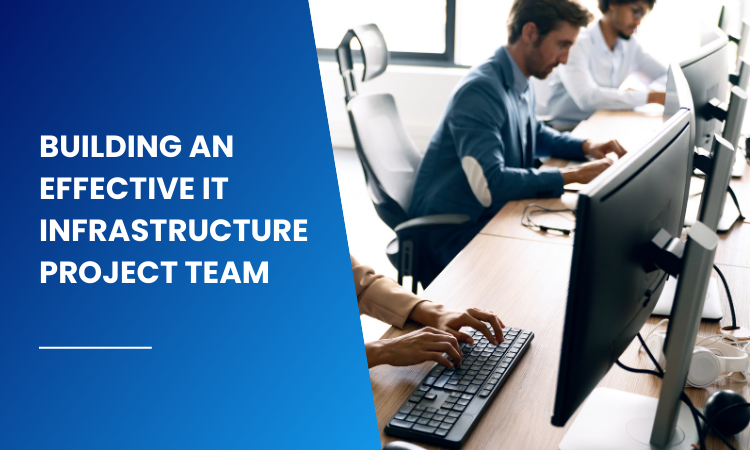
7. The People Behind the Project: Building an Effective IT Infrastructure Project Team:
Any project to improve IT systems depends on the people who work on it. How to put together a good project team that can handle the challenges of building a strong IT foundation:
Technical Know-How: The team needs to have a strong base of technical know-how. This group includes IT experts who know a lot about hardware, software, networking, and maybe even cloud technologies, based on the size of the project.
How to Manage a Project: A good project boss is very important. They need to be very good at staying organized, keeping track of deadlines and budgets, and communicating clearly so that everyone is kept up to date.
Leadership: Good guidance is very important. The person in charge of the project should be able to inspire and encourage the team, making sure that everyone works together toward the same goal.
Business Intelligence: Don’t forget how important it is to have business intelligence. Bring people to the team who know what the company’s main goals are and how the IT infrastructure project fits in with those. That way, the project will be sure to offer solutions that really meet the needs of the business.
The Communication Catalyst: It’s important to communicate well. The group needs someone who is great at communicating clearly and concisely with others in the group and with people outside the group. This keeps everyone on the same page and stops confusion.
The Open-Minded Thinker: The Open-Minded Thinker says to accept different points of view. Think about including someone who can question ideas and come up with new ways to solve problems. This helps people be creative and makes sure the project uses the newest ideas and tools.
8. Collaboration is Key: Streamlining Communication in IT Infrastructure Projects:
Since (IT infrastructure project management) is so complicated, it’s important to communicate clearly and consistently. Streamline communication within your project team and with clients to make sure everyone is up-to-date and on the same page:
How to Define Communication Channels: Create clear ways to communicate right away. Utilizing a project management tool with built-in communication features, setting up regular team meetings, and assigning specific points of contact for each partner could all help with this.
Expectations for Communication: Outline the standards for communication for everyone on the team and in the broader context. Establishing preferred ways of communication (such as email, instant messaging, and project management tools), response times, and the amount of detail needed in updates are all part of this.
Embrace Openness: Encouraging trust and teamwork is what transparency does. Discuss project reports on a regular basis, including both successes and problems. This enables preventative problem-solving and keeps everyone up to date.
Employ Visual Aids: Don’t undervalue the strength of showing things to people. Utilize project timelines, flowcharts, and diagrams to clearly show goals and progress. To make sure everyone understands difficult information, visual tools are helpful.
Utilize Technology: Software for managing projects and tools for working together can be very useful. With features like sharing documents, centralized job management, and real-time communication, these platforms make it easier for people to work together and share information.
Listening and Encouraging Feedback: Communicating well requires both listening and giving feedback. Encourage comments and actively listen to what your team members have to say. Making sure everyone feels heard and valued creates a sense of control.

9. Budgeting for Success: Cost Considerations in IT Infrastructure Project Management:
Many businesses need to invest in IT infrastructure projects in order to grow, but these projects can be very expensive. To make sure your project provides value without going over budget, you must master the art of cost management. When managing an IT infrastructure project, here are some important things to think about whenever it comes to costs:
Hardware and Software Costs: The upfront cost of buying new gear, software licenses, and any maintenance or subscription fees that go with them are all included in the hardware and software costs. When it makes sense, carefully think about what you need and look at ways to save money, such as using open-source software or refurbished hardware.
Labor Costs: Think about how much your IT team members and any outside experts working on the project will be paid. You might also want to think about how much it will cost to train your team if they need to learn new skills to use new tools.
Management Software for IT Infrastructure: Long-term, these tools can be very helpful, but they may cost money to license and set up. Different tools have different features, so you should compare them and pick the one that fits your project needs and price the best.
Cloud Migration Costs: When planning to move your business to the cloud, you should think about all the costs that come with it, such as the fees charged by the cloud provider, the costs of moving data, and the chance that your apps will need to be redesigned to work best in the cloud.
Hidden Costs: Remember that there may be costs you didn’t expect. During the execution phase, this could include things like new hardware using a lot of power, the need for more cables, or unexpected problems with business operations.
Long-term Planning: There are more things to think about than just the job costs. Also think about possible long-term costs, such as the amount of power used, the cost of renewing licenses, and the cost of maintaining new tools and software.
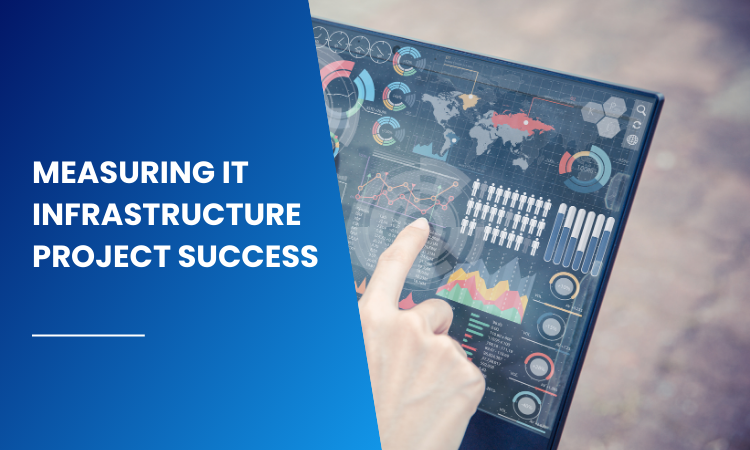
10. Measuring IT Infrastructure Project Success: Key Metrics to Track and Analyze:
Finishing an (IT infrastructure) job well is only the beginning. To really know how it changed your business, you need to figure out how successful it was. Here are some important measures to keep an eye on and study:
Project Success Rate and Timeliness: Did the project stay within the time frame and goals that were set? Monitoring how well goals and deliverables are met helps figure out how well a project worked and where improvements can be made for future projects.
Return on Investment (ROI): This number measures how much money the project will make. Find out if the project gave a good return on investment by looking at whether it saved money, increased productivity, or made things run more smoothly.
System Availability and Performance: Making sure systems are available is one of the most important jobs of IT infrastructure. Track metrics such as uptime percentage, server response times, and network latency to get a sense of how well your infrastructure is running generally and find places where it might be slowing down.
User Satisfaction: Users who are pleased with the project are a good sign that it worked. Users should be asked to fill out surveys or be interviewed to find out if the new technology meets their needs and makes their work experience better.
Number of Help Desk Tickets and How Quickly They’re Solved: Check the amount of help desk tickets that were sent in after the project was put in place and how often they were resolved. A lower number of tickets can mean that the user experience is going better, while a higher number of tickets could mean that more training or changes need to be made.
Security Status: Breach of security can have terrible effects. Check security measures like the number of intrusion attempts, malware detections, and patch compliance rates. These metrics give you information about how secure your IT system is as a whole.
Conclusion:
You’re not just building technology when you put IT infrastructure project management at the top of your list of priorities. You’re investing in the future of your business. You’ll be able to use the newest technologies, make the most of cloud strategies, and easily integrate powerful IT infrastructure project management tools if you have a solid IT foundation. You can decide what will happen with your IT by planning your next project right now. This will help your business stay flexible and competitive for years to come.



